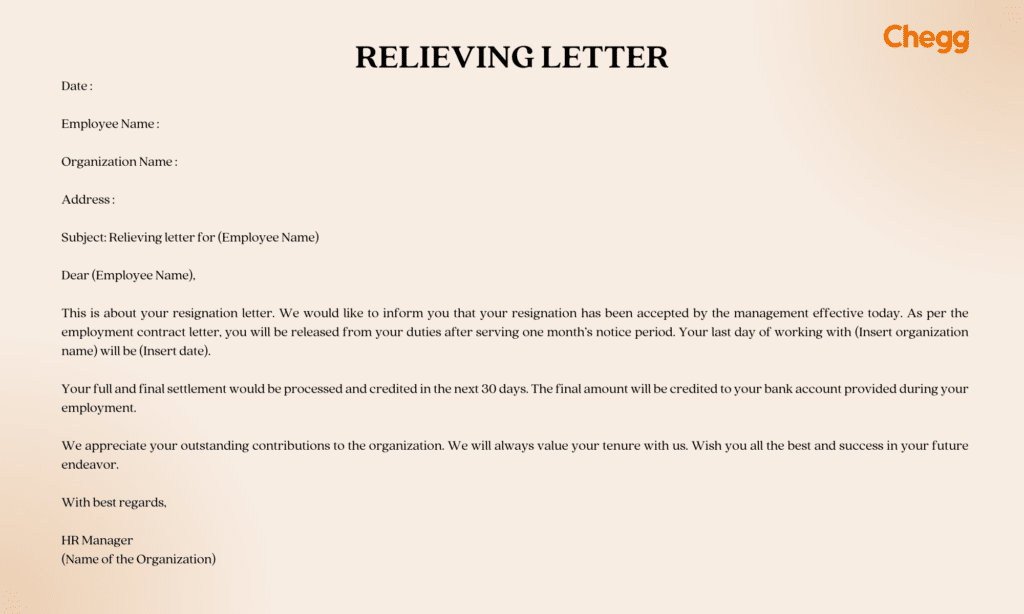
Table of Contents
Every organisation is particular about onboarding the right employees. Most people are in constant search of good opportunities. At some point, the majority of people make a job switch for a better hike, learning opportunities, and taking up a new role. A piece of document that validates releasing an employee from their job is the relieving letter.
The relieving letter format includes all information like the employee’s last working date, effective relieving date, and resignation acceptance. The article further delves into its importance along with a few samples for reference.
Also Read: Resignation Letter Format with Samples
What is Relieving Letter?
A relieving letter is a formal letter issued to an employee upon leaving an organisation. The official document relieves the roles and responsibilities of the employee through formal communication. Every organisation has its own relieving letter format mentioning important information. The document confirms the resignation of the employee along with the late date of employment.
Most companies ask for a relieving letter at the time of new joining. Usually, HR Department prepares the document. The letter consists of information like the final date of employment, joining date, CTC, job responsibilities etc. The relieving letter format for an employee might differ from place to place.
What is the Need for Relieving Letter?
The relieving letter is a formal acknowledgment of releasing an employee from their roles and responsibilities. It gives all the important information packed in one document. The document is a mandatory requirement for big companies as it builds trust and reliability. In short, it is a formal end to an employee’s service for a company.
Here is the importance of the relieving letter:
- It acts as proof that the employee is relieved from their job. The document indicates the employee has served the notice and the resignation is accepted.
- The relieving letter confirms to the new employer that the employee is free from the service. It shows the new employer that there were no issues with the employee’s departure.
- Mostly, new employer requests it. Failure to provide the letter compromises the otherwise onboarding process.
- The format of relieving letter consists of all necessary and relevant information. This reduces the new employer’s hassle of cross-checking everything. It summarises critical employee data for the new employer.
- It is proof that shows that a person is no longer a part of the former organisation. Also, it mentions that all dues are clear.

Relieving Letter Format
The relieving letter requires a format. It is a professional formal letter making the format a critical element. The relieving letter format for employees remains the same for all organisations. Use crisp and simple language to create the letter. Here is the important information necessary for the same:
- Date of issue
- Employee information – Name, Designation, Employee ID,
- Organisation Information – Name, Address
- Subject line
- Greeting or Salutation
- Employee Resignation Information – Including resignation acceptance, Date of release from duty etc.
- Assurance – Full and final settlement assurance for employee
- Express appreciation
- Signature
Here is the Employee Relieving Letter Format
Date [DD/MM/YYYY]
Employee’s Name
Employee Designation
Employee ID
Company/Organisation Name
Address
Subject:
Salutation [Mr, Ms, Mrs, Dr] Name,
The first paragraph is for the resignation information. Confirm acceptance of the resignation of an employee from the designation. Mention the last day of work. State the date when the employee is released from all roles and responsibilities.
The second paragraph is to assure the employee that all due will be settled. Mention the date or number of days when the due will be settled or the customer will be paid in full. Express appreciation for the employee’s contribution. Also, wish you good luck in any future endeavors.
Sincerely/Warm Regards
Employer’s Name
Designation
Detailed Relieving Letter Format

Details Required in a Relieving Letter
The relieving letter word format includes the following details:
- Date of Issuance – The first section includes the date of issuance of the relieving letter. It is mentioned on the top of the letterhead. It reduces the chances of disputes. It helps old employers keep track.
- Employee details – This section includes all the details of the employee. The information mentioned is name, employee ID, designation, department, and company name.
- Subject line – It is the focal point of attention. A clear, concise subject line states the purpose of the letter. Instead of simply using the Relieving Letter, make it a practice to mention the name. For example: Relieving letter for Andy Ghosh.
- Greetings/Salutation – Professional correspondence without a formal salutation is incomplete. It is a basic courtesy to start the body with a salutation. For example, Dear Andy, or Dear Mr. Ghosh sounds good.
- Details of Resignation – The body is followed by a formal salutation. This majorly includes information on acceptance of resignation. In the first paragraph, write on acceptance of resignation of the employee from the company. Include the date of resignation, last working day, designation, and job roles or responsibilities.
- Statement of assurance and appreciation – Avoid making the relieving sound like an essay. keep it crisp and concise but inclusive of relevant information. The second paragraph is about assuring the employee of receiving a full and final settlement. Mention the period to process the settlement amount. A statement of appreciation must be after the assurance. The assurance statement mentions appreciation towards the contribution of the employee. Also, wish you the best wishes for future endeavors.
- Signature – Once the body is complete, end the relieving letter format with “Warm Regards” or “Sincerely”. Sign the letter with the employer’s name, designation, and company name.

Relieving Letter Template and Sample
Here are two samples of Relieving Letters:
Sample 1
Date
To,
Employee Name
Job Title
Employee ID
Address
Subject: Reliving letter for (Employee Name)
Dear (Name),
We hope you are doing well. This letter is to acknowledge acceptance of your resignation dated (Insert date, month, and year). We wish to inform you that you are relieved from your position of (Insert designation) with (Insert company name) effective from (Insert date, month, and year).
It is to inform you that your full and final payment will be settled within 30 days from your last working day. We appreciate your contributions to our organisation. It has been invaluable in our growth. Wish you all the best of luck in all your future endeavours.
With Regards,
(Name)
HR Manager
(Authorised signature)
Sample 2
Date
Employee Name
Organisation Name
Address
Subject: Relieving letter for (Employee Name)
Dear (Employee Name),
This is about your resignation letter. We would like to inform you that your resignation has been accepted by the management effective today. As per the employment contract letter, you will be released from your duties after serving one month’s notice period. Your last day of working with (Insert organisation name) will be (Insert date).
Your full and final settlement would be processed and credited in the next 30 days. The final amount will be credited to your bank account provided during your employment.
We appreciate your outstanding contributions to the organisation. We will always value your tenure with us. Wish you all the best and success in your future endeavour.
With best regards,
HR Manager
(Name of the Organisation)
How to Write a Relieving Letter?
The above-relieving letter samples give an idea of how to write a formal letter. The language must be professional and crisp. The formatted document is issued to the employee after accepting the resignation. The letter mentions relieving the employee from their duties. Here are a few things to consider while writing a relieving letter:
- The letter should always be written on the company letterhead. It must include the company logo and be issued on only authorised letterhead. This prevents employees from creating fake relieving letters.
- “To Whomsoever It May Concern” is an ideal salutation. Stick to this unless the employee mentions something specific.
- Always mention the acceptance of employee resignation along with designation.
- Always mention important dates. This includes the date of acceptance of resignation and the last working date.
- You may also mention the joining date and CTC. However, it is not mandatory.
- The formal and polite tone throughout the letter.
Most organisations have a set relieving letter format. As soon as the employee resigns and is accepted, the organisation must provide the employee with the formal document.
Asking relieving letter after resignation
The employee requested the relieving letter after submitting of resignation letter. As an employee, follow the formal procedure to request the letter by writing to HR:
- Draft an email to the HR Manager requesting the relieving letter. Keep it concise.
- Inform of the date of resignation. Also, mention the designation or position you have resigned. Make sure to mention the exact tenure in the organisation.
- Mention the name of the reporting manager, if any. It makes it easy for the HR manager to communicate and reach out to the manager.
- Request the formal document. Do mention the urgency of the situation.
- Attach a copy of the resignation letter along with the email.
- Wait for HR’s response. If there is no response, send a follow-up email requesting the relieving letter.
- Contact the HR Manager or reporting manager in case of delay.
Conclusion
Many employees underestimate the importance of a relieving letter. A lot of people also confuse between relieving and a resignation letter. An employee writes a resignation letter requesting resignation from the designation of the company. The relieving letter acknowledges acceptance of resignation and releases employees from their duties.
A relieving letter is important both for the employer and the employee. The employer adds it to the database to keep a record of all the past employees. The formal document is acceptance of employee’s resignation. It makes clear that the notice period is over and now the employee is released from the company. It also clarifies any dues or settlements.
Using an existing format or template makes it easy to write a relieving letter. The customisable templates make the whole process of writing relieving letter easy. In summary, the article gives important inclusion necessary through relieving letter sample and template.
Frequently Asked Questions
What is the importance of a relieving letter?
The relieving letter acts as formal communication of releasing an employee from their job. New jobs or joining often demand the letter. It mentions necessary details like the date of joining, last working day, CTC, job responsibilities, etc. Also, It acts as proof of the employee is no longer working with the previous organisation. It validates the acceptance of resignation.
Who writes a relieving letter?
The relieving letter in the majority of companies is written by the HR department. However, even the manager or senior management is entitled to provide the same.
Is a terminated employee eligible for a relieving letter?
Yes, a terminated employee is eligible for getting the letter if the employment term is more than six months. But, it mentions the reason for termination.
What is the difference between an experience letter and a relieving letter?
The relieving letter mentions the organisation accepting the employee’s resignation. HR department prepares it. It mentions important information like employment dates, last working date, and no dues.
Experience letter mentions the employee’s work experience with the organisation. It mentions the tenure, designation, and job description. It includes the service history of the employee.
Can an employer deny a relieving letter?
In some cases, relieving letter can be denied. Example – If an employee has absconded or has less than six months of tenure. However, an employer must provide the letter when the employer followed standard protocol.
Related Reads:
To read more related articles, click here.
Got a question on this topic?